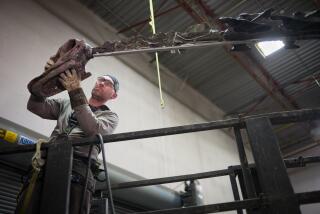New Species of Dinosaur Discovered Hiding in the Basement
- Share via
CLEVELAND — A 70-foot dinosaur known as Happy stood prominently on display at the Cleveland Museum of Natural History for nearly 25 years before researchers discovered it was a new species.
Four months before it announced that finding in July, the museum said it had discovered a new dinosaur, nanotyrannus--based on a skull that had been in the basement for decades.
This spring, a California researcher found the fossil remains of a marine reptile called a masasaur, so well-preserved that the 75-million-year-old animal still had scales on its skin and food in its stomach. It was in a warehouse of the Natural History Museum of Los Angeles County.
Paleontologists say the finds aren’t surprising. Museum storerooms have become rich hunting grounds for new species because a lack of money and staff has delayed the identification of bones excavated up to 60 years ago.
“In general, paleontologists can collect stuff faster than it can be prepared,” said Michael E. Williams, who helped identify Happy, a 140-million-year-old relative of the brontosaurus. “There are museums . . . which have skeletons still in plaster jackets going back to the turn of the century.”
Researchers at the Cleveland museum had determined that Happy was a haplocanthosaurus, but didn’t realize it represented a new and larger species--and named it “delfsi” after the researcher who found the bones 30 years ago--until they recently had time to study it more closely.
“Literally there is so much material to collect and save from weathering and erosion that we are just decades behind,” said Lawrence G. Barnes, curator of vertebrate paleontology at the Natural History Museum of Los Angeles County. “I could walk in to the Smithsonian or any museum and find 80 or 90 new species of whales or dolphins, which is my specialty.”
Barnes estimated that the museum had 300 to 400 plaster jackets in storage, encasing everything from dinosaurs to mammoths, and that 75% of the museum’s collection has not been examined closely.
Even at the well-funded Smithsonian Institution, it took half a century to study and identify fossils excavated by 19th Century dinosaur researcher O. C. Marsh that form the bulk of the museum’s collection, according to research curator Nicholas Hotton.
“When Marsh died, we got seven big, big train carloads of dinosaur bones,” Hotton said. Researcher C. W. Gilmor worked on Marsh’s fossils for nearly 50 years, and “there is a bunch of stuff Gilmor didn’t get to.”
Field Museum of Natural History researchers in Chicago have spent 10 years working through the collection of unstudied fossils, some of them in storage for decades, said John Bolt, chairman of the geology department. “We’ve made quite a bit of progress at reducing that backlog,” he said.
Mary Dawson, curator of the Carnegie Museum of Natural History in Pittsburgh, said some of the fossils still stored in plaster jackets at the museum date to 1922. With only five paleontologists on the staff, many of those blocks will have to remain in storage.
Four years ago, a National Science Foundation grant let Carnegie researchers open an old plaster block. They found the only known complete hind foot of a stegosaurus. “We liken our collection to an iceberg, with one-tenth above the surface and the rest waiting for study,” Dawson said.
Most of the work done at the museum is based on specimens the researchers collect themselves, so much of the collection in storage will remain unstudied, she said. “We know we should stay home and study the collections we already have, but it’s such a challenge to get out in the field.
“We’re really putting apples back on the tree when we do this.”
More to Read
Sign up for Essential California
The most important California stories and recommendations in your inbox every morning.
You may occasionally receive promotional content from the Los Angeles Times.










